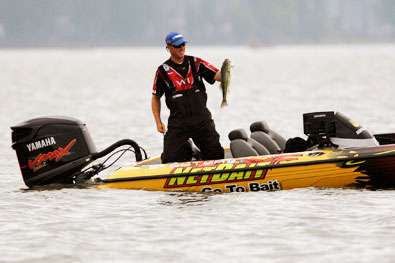
If you’re like most bass anglers, you probably consider yourself pretty adept at fishing down to 10 feet or so, maybe a little deeper if you throw a lot of big crankbaits or live near a highland reservoir. Deeper than that, though, and most of us struggle. Sure, we can wind a crankbait or drag a Carolina rig, but confidence in the depths eludes most of us. Luckily, help is on its way in the form of Bassmaster Elite Series rookie Greg Vinson.
|
More Tips & Techniques
|
|||
|
|
Vinson’s rookie season in the Elite Series has been a strong one. He made the final cut at Lake Dardanelle and has been cashing checks more often than not. With a strong finish at Oneida Lake, the Alabama pro will be bound for his first Bassmaster Classic in 2010.
He didn’t get there without being versatile, and part of being versatile is being able to fish all parts of the water column. But it wasn’t that long ago that Vinson considered himself “the worst deep water bass fisherman in the world.”How did he change that?
1. Quality Electronics
“With today’s sonar and GPS units, we have better access to deep water information than ever before,” Vinson says. “With a basic understanding of your depthfinder and GPS and a little time spent looking at maps and some of the terrific tools that are available online, you can put yourself on deep water fish faster than ever.”Vinson uses his electronics to target spots that others might miss, but is careful not to overlook the obvious. After all, if a place looks good on paper or on the screen, it’s likely to produce even if it does get attention from other anglers.”I can identify potentially productive creek channels, humps, secondary points and other deep water structure without ever leaving home by using my computer and mapping software,” the amiable angler says. “The technology is amazing and anglers who fail to take advantage of it are falling behind.”
2. Visualize
The thing that creates the biggest problem for most bass anglers trying to fish deep water is that they can’t see what they’re fishing. In the shallows, they can watch their spinnerbait bump the stump, but in the depths they’re lost.I turned a big corner in my deep water and offshore fishing by learning to visualize,” Vinson says. “For me, it’s important to think about what my bait is doing. I want to be tuned in while it’s brushing up against a stump or crawling down a ledge. If I can visualize it, I’m going to do a better job of fishing it.”
3. Current CountsJust because you don’t see the riffles and pools like you would in a shallow, fast moving stream doesn’t mean that your favorite lake or reservoir doesn’t have current. It almost certainly does, especially if it’s a reservoir with a hydroelectric dam.Current does several things that stimulate fish activity. For one, it oxygenates the water. For another, it moves forage. Bass benefit from both, and any bass angler worth his salt knows that current stimulates feeding among bass both shallow and deep.”Look for areas that benefit most from any available current,” Vinson advises. “Main lake points and humps are obvious choices because they’ll likely be in strong current areas and they offer drops and ambush points that the bass will hold behind as they wait for baitfish and other forage to pass. Be there when the current starts and bring your lures by in a natural manner — with the current.”
4. Get in Position
Boat positioning is a critical element in shallow water fishing, but too many struggling deep water anglers forget all about it when probing the depths. Never lose sight of the importance of boat positioning — and the angle of your presentation — just because your target is too deep to see.When fishing deep water, you can have fish all around you, but you won’t catch even one unless your presentation is right,” Vinson says. “And that means your boat position has to be right. You have to bring your baits past the fish in the right direction and depth to get them noticed and eaten.”That’s usually pretty easy when there’s current. Just bring the lure back in the same direction as the current, and you’re going to appeal to at least some of the bass. But at other times you may have to experiment before you find the right boat positioning for an area. Just work your way around it, casting from all angles and directions, until you find what works.”
5. Gain Confidence
Ultimately, the biggest key to success in deep water is confidence, and that requires time,” says Vinson. “You’ve just got to pay some dues to get there, and that means putting in some time and being willing to fail … at least in the early stages.For Vinson, finding that critical confidence means being committed to learning how to fish deep. It means setting out for a day on the water and turning your back to the bank and trying a variety of techniques until the fish let you know what’s working. It also means being realistic enough to know that you won’t necessarily succeed right away or even most of the time.”There’s a lot of hit or miss with deep water fishing,” he says. “But when you get on a really strong offshore pattern, you can catch them in numbers and with size like you may never see in the shallows. You’ve just got to stay after it.”




